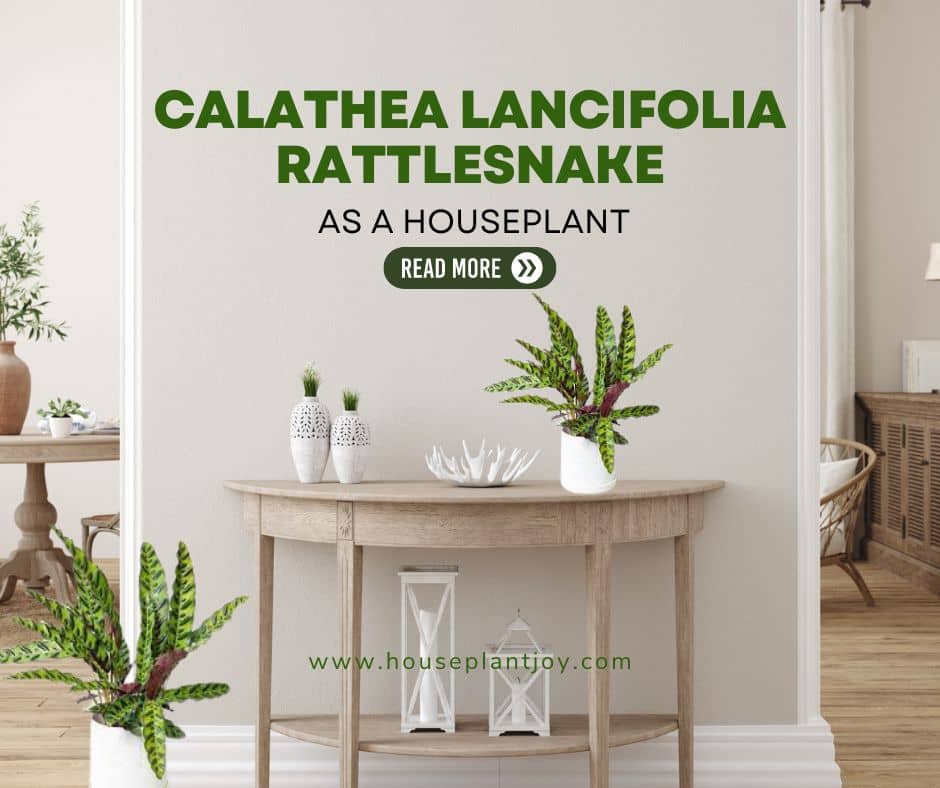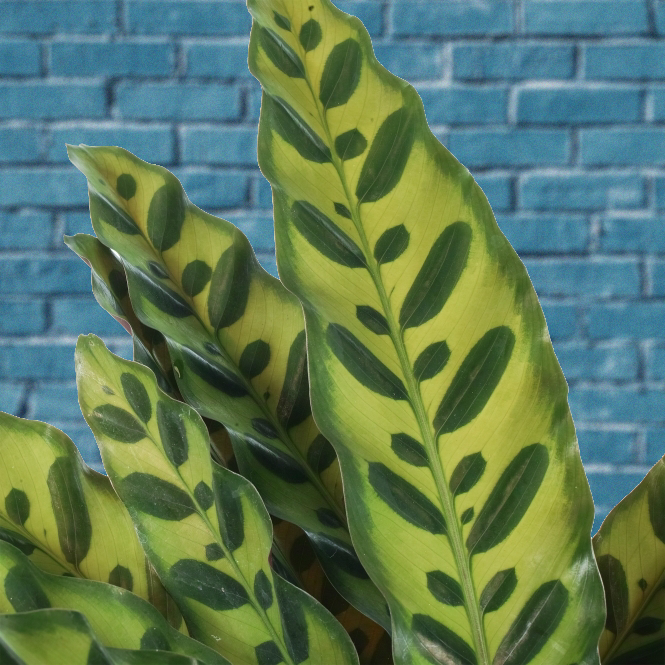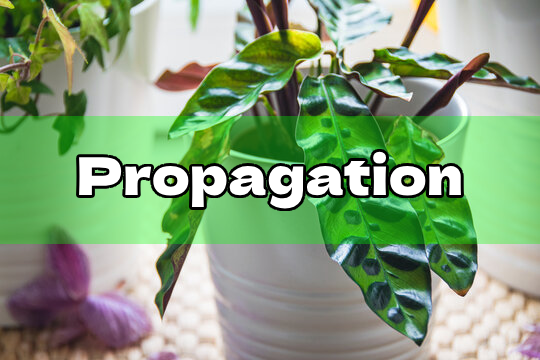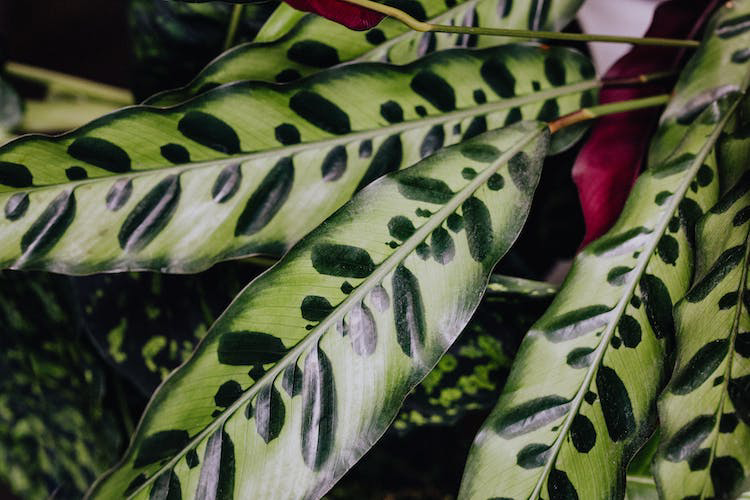HousePlantJoy is supported by our audience. When you purchase through one of our links, we may earn a small affiliate commission. As an Amazon Associate I earn from qualifying purchases. Your cost is not affected.
==================
There’s this plant from the Marantaceae family, which goes by Calathea Lancifolia Rattlesnake Plant. The cool thing is it gets that name from its eye-catching patterns. The leaves are long and slim, with cute ruffled edges that you won’t find in other Calathea species. The colorway is vital, too – the leaves are this vibrant green with these alternating dark-green designs running down each one. When you flip those leaves over, you’re met with a lovely shade of purple. Also, just like the prayer plant, they’ve got a bedtime routine, too – folding up at night.
Calathea Lancifolia Rattlesnake Plants
The Rattlesnake plant (Goeppertia insignis) is a green plant that stays alive all year and comes from Brazil. People usually grow it inside their houses. Taking care of it might be a bit challenging, but if you give it the right care, you’ll see some really cool leaves. These leaves have wavy edges and are mix-and-match with different shades of green.
With nature, the Calathea Lancifolia Rattlesnake plant puts on little yellow flower shows in springtime. But when it’s indoors, it’s all about the long, fancy leaves – flowers don’t really happen inside. As a houseplant, it usually hangs around 20 inches tall and grows at a regular pace. However, if it’s not feeling the vibe, its growth might slow down or stop. Remember, a Happy plant, keeps on growing; an unhappy plant, takes a break.
Growing Calathea Plants
Repotting
In spring, every year or two, it’s makeover time for your plant. Repotting means a bigger home and new soil. But not too big – just 2 inches larger than before. Big pots can drown your plant and cause root problems. When you move it, keep the Calathea Lancifolia Rattlesnake at the same level in the soil as before, not too deep.
Maintenance
Big leaves love to collect dust, and that’s not cool. Every now and then, give them a wipe with a damp cloth. Hold each leaf from below and clean gently. This helps the leaves soak up sunlight for their energy.
Browning on Leaves
Brown tips on leaves? Maybe too much salt in the soil (see “Flush Salts” below) or dry air. Winter can make things really dry, and your tropical plant pals won’t like it. If your home is dry, here’s how to add some humidity for your plants.
Flush Salts
Calathea Lancifolia Rattlesnake don’t like stuff like fluoride, chlorine, and extra salt from fertilizer. If you see white stuff on the soil, that’s extra salt – bad news. To fix it, give the soil a rinse once a year. Pour room-temperature distilled water on the soil, let it drain, pour a bit more, and empty the tray underneath. Your plant will love it.
Calathea Lancifolia Rattlesnake Houseplant Care
Rattlesnake plants might not be the best choice if you’re just starting out with houseplants. They’re a bit demanding when it comes to warmth, light, and water. But, their stunning leaves can make all the effort worthwhile.
Watch out when cleaning those big leaves – fancy sprays can make the tips turn brown. Stick to a damp cloth to wipe off dust and keep them healthy.
While you might spot them outdoors in warm spots, they’re more commonly kept inside. These tropical plants need lots of warmth and humidity to thrive.
Plant Soil
Go for soil that drains well. These plants don’t like soggy feet but enjoy staying a bit damp. You can use sandy soil or a mix of peat moss and perlite. Rattlesnake plants like soil that’s a bit acidic or neutral, but don’t go for alkaline soil.
Watering
In the summer, when your rattlesnake plant is growing a lot, water it often to keep the soil damp. In winter, wait until the top layer of soil is dry before watering again.
Don’t drown your plant – if the leaves turn yellow, you might be giving it too much water. But if the leaves curl up, it’s thirsty.
Give it frequent but small sips of water, not a big soak. Water until it starts coming out of the bottom, but don’t let it sit in the extra water. Pour it out and don’t put the extra water back in.
Filtered Light
Go for filtered light – it’s what your rattlesnake plant likes. If you’re thinking of putting it by a window, avoid the direct blazing sun in the afternoon. You can use curtains to soften the light. A bright corner in a room with good light is a good idea too.
Fertilizer
Give your rattlesnake plant some food every month when it’s spring and summer – that’s when it’s growing a lot. Use a balanced liquid fertilizer to help its leaves grow healthy and strong. Just follow what the label on the fertilizer says about how much to use.
Humidity Level
Keep things comfy for your plant – it likes temperatures between 60 and 75 degrees Fahrenheit. If it gets too cold, the leaves might droop, turn brown, and eventually say goodbye.
Watch out for cold drafts, dry air, and sudden temp changes – they’re not its pals. Make sure it’s not hanging out near heaters or AC units, so it doesn’t get all dried out.
To make the air cozy, put your potted plant on a tray with pebbles. The water will hang out there, keeping things moist. You can also give it a little mist or take it into the bathroom while you shower. And if you’re really into tropical plants, think about getting a humidifier. It’s like a comfy spa day for your plant.
Propagation of Rattlesnake Plant
When your plant starts getting big, you can actually divide it into smaller parts. This is kind of like giving it a haircut to help it grow better. The perfect time to do this is in spring when it’s getting all energized and growing like crazy. So, just picture it like this: when spring rolls around and your plant is stretching and reaching for the sky, that’s when you can give it a little snip and make new plant friends.
1.) The day before you’re all set to divide and repot, give your plant a good drink of water. This little trick actually helps lower the stress for the plant, making things easier.
2.) Now, time to pick a pot. You want a pot that’s big enough for the new root ball that’s going to happen when you divide the plant. Opt for something like plastic, metal, or glazed ceramic with holes at the bottom. These types of pots are perfect because your rattlesnake plant loves a nice, moist home.
3.) Let’s prep the pot. Start by filling about a third of it with potting soil mixed with some perlite. This combo gives your plant a cozy and comfy spot to settle in.
4.) Get ready to do the divide-and-conquer dance. Put the potted plant on its side so you can gently slide the root ball out of its current home.
5.) Time for root talk. Slowly brush away the soil from the roots, and start gently pulling them apart with your fingers. Think of it like a little root-untangling party – just don’t make any roots break up if they don’t want to. If you see any damaged or sick parts, snip them off with clean and sharp gardening scissors.
6.) It’s time for the big move. Put the divided root ball into its new pot and fill up the gaps with soil. You can use some of the soil from the old pot – it’s like giving the plant a familiar touch.
7.) It’s time for a nice drink. Water your newly potted plant until you see water coming out of the bottom of the pot. It’s like a sip for your plant’s roots.
8.) Want to give your plant a cozy start? You can try this greenhouse trick. Loosely cover the plant and pot with a clear plastic bag. Leave it on until you see some new growth, then you can take it off and treat your plant like normal. It’s like a little shelter for your plant to settle in before facing the world on its own.
Some Challenges with Rattlesnake Houseplants
Your plant’s leaves and stems talk to you when things aren’t right. Usually, it’s because of watering. But here are some common issues you can fix to make your plant happier.
Browning of the Leaf Edges
If the edges of the leaves turn brown, it’s like a signal that your plant wants more moisture in the air. And if the leaves curl up, that’s a sign the air is too dry. To help your plant, make the air more humid where it lives.
Fading of Patterns
Think about the light for your rattlesnake plant. If it gets too much sun, it might get green spots. But if there’s not enough light, its cool spots might fade. Keep an eye on the light balance.
Stems are Rotting
When it comes to stems, there are two things to watch out for: too much water or chilly drafts. If you water your plant a lot in cold weather, its stems might get weak. And if the roots sit in water, they could rot, which isn’t good. If this happens, try putting your plant in a warmer spot with steady temperatures and see how it reacts.
Elevate Your Space: Mastering Calathea Lancifolia Care
The Calathea Lancifolia Rattlesnake is a fantastic choice to brighten up your home. Its stunning leaves do demand a tad more care, but trust me, the results are totally worth the effort.
Here’s the deal: give it some comfy filtered light, water it just right, and don’t slack on the humidity. Give this plant some love, and it’ll transform your space into a lush paradise you won’t be able to take your eyes off.
For more insider tips on plant care and creating your own green oasis, make sure to check out the HousePlantJoy blog. Your journey to a vibrant and thriving home jungle starts there!
FAQs
Does My Rattlesnake Plant Need Pruning?
Usually, nope. If you see a leaf you don’t like, just snip it off near the stem with clean scissors and toss it away.
Are Rattlesnake Plants the Same as Prayer Plants?
They’re similar but not twins. Rattlesnake plants (Goeppertia insignis) and prayer plants (Maranta spp.) are part of the same plant family. They both have cool leaves with movement at night. The difference? Rattlesnake plants stand tall, while prayer plants can hang down, and their leaves look a bit different too.
Why Do Rattlesnake Plants Move at Night?
These plants like to put on a show. At night, their leaves point up, and during the day, they come back down. It’s like they’re doing a little dance to catch the light and water they need.
How often should I water my Rattlesnake plant?
Keep the soil damp but not soggy. Water when the top part of the soil feels dry to the touch. In winter, ease up a bit to prevent overwatering.
?Embark on a Green Adventure with Rattlesnake Plant Joy!?
Dive into the fascinating realm of rattlesnake houseplants and gardening through our captivating social media platforms! ?
? Connect with Fellow Enthusiasts: Join our Facebook page, HouseplantJoy, to uncover pro tips and connect with like-minded plant lovers.
? Visual Treats on Instagram: Immerse yourself in mesmerizing plant snapshots, reviews, and become part of the community at HouseplantJoy on Instagram.
? Pin Your Green Fantasies: Discover a universe of garden inspiration on our Pinterest boards at HouseplantJoy on Pinterest.
? Tweets for Plant Enthusiasts: Stay in the loop with gardening trends and interact with us at HouseplantJoy on Twitter.
? Green Adventures on TikTok: Short on time? Catch swift plant insights and entertainment on HouseplantJoy on TikTok.
Join us virtually, nurture your passion, and flourish alongside a community that shares your fondness for rattlesnake houseplants! #RattlesnakePlantJoy







